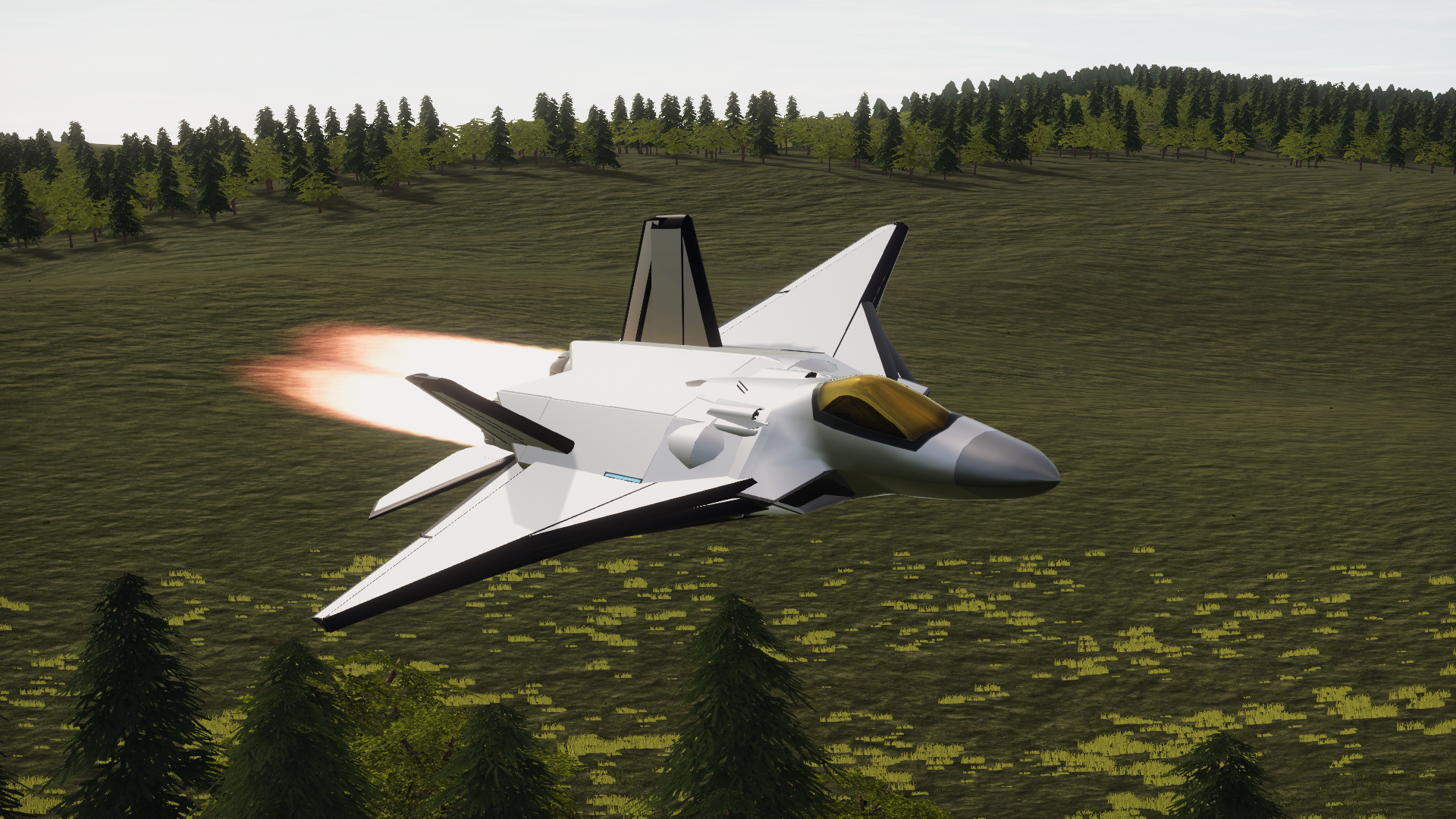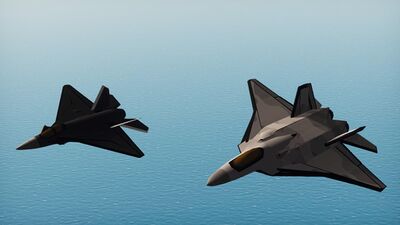E-37 Kamino
|
E-37 Kamino
E-37 Kamino
|
|||||
|---|---|---|---|---|---|
| Air Superiority Fighter | |||||
 |
|||||
| An E-37D Kamino (E48-016) from the 22nd Fighter Squadron performing air interdiction mission during the 2152 Zeoulian Rebellion. | |||||
| National Origin | Sarconia | ||||
| Production History | |||||
| Produced | |||||
| 2144 - ongoing | |||||
| Designer | Kerbin Micro Electronics | ||||
| Unit Cost | 48,000(√) | ||||
| Number Built | 270 | ||||
| Service History | |||||
| In Service | |||||
| 2144 - ongoing | |||||
| Used By | Sarconian Air Force Royal Hermish Air Force | ||||
| Aircraft Characteristics | |||||
| Dry Mass | 17.6 | ||||
| Length | 13.5 m | ||||
| Width | 10 m | ||||
| Height | 3 m | ||||
| Propulsion | 2x Corain Motors J334 Afterburning Turbofans | ||||
| Operational Range | 1600 km | ||||
| Crew | 1 | ||||
| Sensor Systems | A/FRC-3 - Radar BIAv5 - Datalink A/FAQ-13; A/FAQ-27 - Electro-optical Targeting System/Infrared Search and Track A/FSP-62 - Radar Warning Reciever and Missile Launch Detector A/FCQ-32; A/FCQ-36 - Electronic Warfare System |
||||
| Variants | E-37A E-37B E-37C E-37D |
||||
The Kerbin Micro Electronics E-37 Kamino is a joint Sarconian-Hermish single-seat, twin-engine, all-weather stealth tactical fighter aircraft in service with the Sarconian Air Force and Royal Hermish Air Force (RHAF). Developed as a significant re-design of the failed Hermish Dynamics E-30 program, the E-37 was designed to be Sarconia's premier air superiority fighter . While designed as an air superiority fighter, the E-37 eventually gained ground attack and electronic attack capabilities. 250 E-37D are currently in service with the SAF and RHAF.
Development
Failed Program and Re-design
WIP
Design
The E-37 Kamino is a 5.5-generation stealth air superiority fighter. The E-37 has a tailed compound delta wing blended into the fuselage with a pair of vertical stabilizers. Flight control surfaces include flaperons/elevons, ailerons, rudders on the canted vertical stabilizers, and all-moving horizontal tails (stabilators). The E-37's aerodynamics, relaxed stability, advanced thrust-vectoring engines, and Advanced Flight and Engine Control System(ADECS) give the E-37 excellent maneuverability and high alpha characteristics. The ADECS allows the aircraft to fly at alpha in excess of 60° while maintaining full control, making the aircraft very departure-resistant.
The aircraft's twin Corain Motors E-334 afterburning turbofans incorporate 3D thrust vectoring nozzles with a range of 10° in every direction; each engine has a max stationary thrust of 192kN(~43,150lbf) while reaching as high as 452.6kN in certain flight conditions. The aircraft's thrust-to-weight at typical combat weight is roughly 1.1 at max military power, 3.0 in afterburner, and as high as nearly 4.94 in certain conditions. While speeds are classified it is believed that the E-37 can super cruise at speeds in excess of Mach 1.3 and has a max speed in excess of Mach 2.5. The engines are fed by a pair of S-duct caret intakes left and right of the cockpit.
While not initially on the aircraft, later variants included internal weapons bays, radar-absorbent materials, an indium oxide cockpit coating, and an electro-optical targeting system.
Variants
E-37A
WIP
E-37B
The B-variant was the most numerous version produced with 120 being procured by the Sarconian Air Force. The type featured new re-designed vertical stabilizers with rudders instead of the all-moving stabilators which increased yaw stability in all envelopes of flight. It also featured 2 centerline hardpoints and a prototype indium oxide cockpit coating. All were retrofitted to the subsequent D-variant later on.
E-37C
The C-variant featured the biggest change in the design. It featured a radar-absorbant coat, a 6-hardpoint internal rotary weapons bay, the A/FAQ-13 targeting pod, the A/FCQ-32 electronic warfare suite, the integration of Precision Attack Munitions, as well as many software changes. The typical mission loadout of 6 air-to-air missiles was a decrease from the 10 on the B-variant but was deemed acceptable due to the significant increase in capability. 40 were produced with 20 being retrofitted B-variants.
E-37C+
The E-37C+ was a proposed stealthier upgrade to the existing C-variants which included a 15° increase in the angle of the vertical stabilizers, as well as an improved radar-absorbent coating. It never entered service due to the proposed increase in maintenance cost and decreased yaw stability.
E-37D
The D-variant features a re-designed weapons bay, the A/FAQ-27 electro-optical targeting system, the A/FCQ_36 electronic warfare suite, and the integration of the Precision Glide Munitions and the new advanced air-to-air missiles. The type is also updated with the latest Battlefield Integrated Awareness datalink system. The re-designed weapons bay replaces the inefficient and complex rotary bay, with 3 separate weapons bays. The 3 weapons bays decreased maintenance costs and allowed the aircraft to carry up to 6 air-to-air missiles, 6 500kg bombs, or 12 250kg bombs internally. 90 were produced for the SAF and RHAF and all previous variants were retrofitted.
Operational History
WIP

